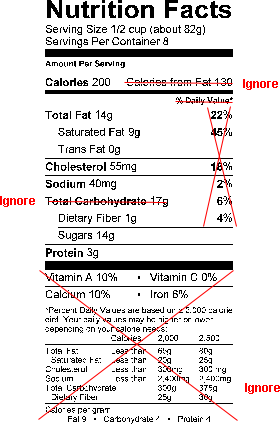What You Need To Know About Nutrition Labels
Most of us do not pay much attention to the details of the ingredients in what we eat, other than those dieting or preparing for competition who need to make wiser choices of food. Nutrition labels first appeared on food packaging in 1990, in the United States after a law was passed to reveal the composition of food content. Labeling was to help people make better nutrition choices. However, many people are still ignorant on the usefulness of this information after so many years. This is a guide to advice you on what to take note and what you can ignore on the labels.
* Serving size and amount of servings per product
This is the amount of food per serving and estimated total amount of food in each product. When reading this, note that what you consider to be a serving may not be the same as product manufacturers since they have different scales for product servings and sizes.
 * Calories
* Calories
This is the amount of energy the food gives. This should be taken in moderation because calorie requirements varies with individuals and lifestyle.
* Calories from fat
This measures the amount of calories derived from the fat found in the food. The focus should be on the total fat content.
* % Daily value
This is the percentage of daily intake the food provides on a daily requirement of a 2,000 calorie diet. Daily requirements varies between individuals. Ignore this.
* Total fat
This is the total combined amount of different fats in the food. Some foods have very high fat content but not all fats are bad. Healthy fats such as mono-unsaturated and poly-unsaturated fats promote fat burning and other benefits such as a cushion to protect your vital organs and promotes healthy cell function. Saturated and trans fats should be limited or avoided if possible as it causes health conditions such as heart diseases and cancer while also act as catalysts for other health problems.
* Cholesterol
This value is not that important as your body manufactures most of the cholesterol in your body compared to those found in food. A guideline provided by the American Heart Association recommends a daily consumption of 300 milligrams or less.
* Sodium
Individuals with heart disease or hypertension need to beware of their daily intake. A healthy individual should consume 1000 milligrams for every 1000 calories of food and less than 2300 milligrams daily as advised by American Heart Association.
* Total carbohydrates
This measures all the energy from starch, sugar and fiber in the food. Unless you are preparing for competition or on diet, ignore this part of the label as what type of carbohydrates in the food is more important.
* Dietary fiber
There are 2 types of fiber, soluble and insoluble fiber. Soluble fiber helps in providing lubricating properties while insoluble fiber helps in moving food within your digestive and circulatory system. Aim for any food with 2 grams or more fiber per serving. Food with higher fiber is more healthier.
* Sugar
Not all sugars are equal. Some sugar like fructose and galactose are natural and found in fruits and milk. What should concern you would be the added sugar to the food. Aim for 5 grams or less sugar per serving.
* Protein.
* Vitamin and mineral percentages
It is a requirement to list the 4 basic micro-nutrients, vitamins “A” and “C”, calcium and iron on all labels. If other micro-nutrients are added as supplement, they must be listed too. You can meet your daily vitamin and mineral requirements by taking multi-vitamins. You can ignore this unless you are having deficiencies or not taking any multi-vitamin supplements.
* Ingredients
Not every food appears to be what they seem to be. Processed foods taste and look better due to the added ingredients such as sugar, sweeteners ...etc, while unprocessed foods are made from natural ingredients and do not taste as good. You can look out for “all natural peanut butter” and compare that with peanut butter that has fancy names. The difference is obvious after you have tasted the 2 types of peanut butter. Use the information to make wiser choices and to check for harmful ingredients that may jeopardize your health if you have allergies or known to cause certain diseases.
In all, this brief guide on nutrition labels is to help you make wiser and better food choices. You should always take your lifestyle and health conditions into consideration when planning your meals. Moderation is key.






